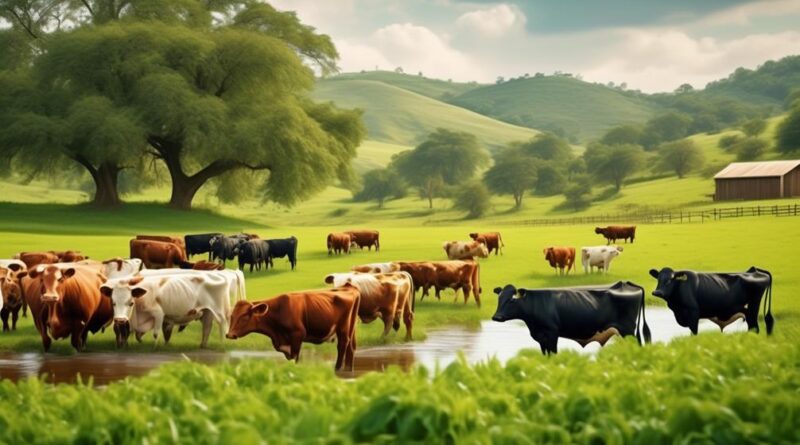Cattle Farming: Soil Health and Sustainability Guide
Imagine a vast, rolling pasture under a clear blue sky, dotted with contented cattle grazing peacefully. Now, picture this idyllic scene becoming even more sustainable and productive.
As a cattle farmer, you may be intrigued by the potential to enhance your soil health and overall sustainability. In this guide, we'll explore practical strategies and techniques that can help you achieve these goals, from sustainable grazing practices and rotational grazing systems to the integration of cover crops and the benefits of agroforestry.
These methods not only contribute to the well-being of your land but also offer long-term benefits for your cattle farming operation.
Importance of Soil Health in Cattle Farming
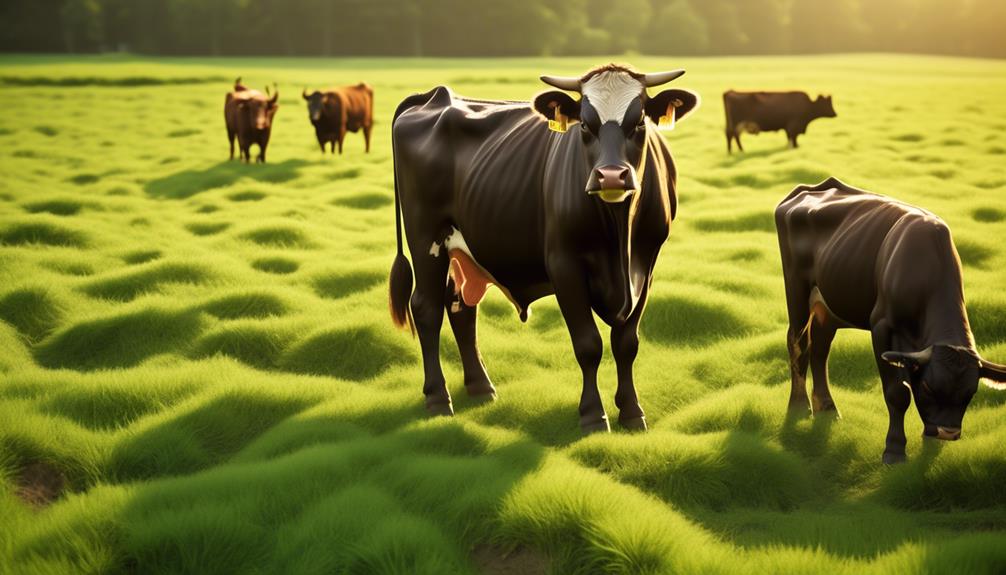
Maintaining healthy soil is crucial for successful cattle farming, as it directly impacts the quality of the forage and ultimately the well-being of your cattle. Nutrient cycling plays a vital role in soil health. It's the process by which nutrients such as nitrogen, phosphorus, and potassium are taken up by plants, consumed by the cattle, and then returned to the soil through manure. This cycle is essential for maintaining the fertility of the soil, ensuring that your cattle have access to high-quality forage.
Soil compaction is another critical aspect that directly affects your cattle farming. Heavy machinery, livestock, and even intense rainfall can lead to soil compaction. This reduces pore space in the soil, making it difficult for plant roots to penetrate and access nutrients and water. As a result, forage quality and quantity can be severely impacted, directly influencing the health and productivity of your cattle.
To combat soil compaction, it's important to implement practices such as rotational grazing and minimizing the use of heavy machinery on wet soils.
Sustainable Grazing Practices for Cattle
To ensure the long-term health and productivity of your cattle, implementing sustainable grazing practices is essential, building upon the foundation of maintaining healthy soil. Grazing management is a key aspect of sustainable cattle farming. It involves carefully planning and controlling the movement of livestock to optimize forage utilization while preventing overgrazing. By rotating cattle through different pastures, you can give the land and vegetation essential recovery time, promoting healthier pastures and reducing the risk of soil erosion.
Pasture rotation is a crucial component of sustainable grazing practices. It allows forage to rest and regrow, ensuring a continuous supply of nutritious feed for your cattle. Rotational grazing involves dividing pastures into smaller paddocks and rotating cattle through them at regular intervals. This method not only prevents overgrazing but also promotes more even utilization of forage across the entire pasture. It also aids in distributing manure more evenly, improving soil fertility and reducing the risk of nutrient runoff.
Effective grazing management and pasture rotation contribute to improved soil health, increased forage productivity, and overall sustainability of the cattle farming operation. By implementing these practices, you can optimize the use of natural resources, reduce input costs, and maintain a healthy balance between livestock and the environment.
Sustainable grazing practices not only benefit your cattle but also contribute to the long-term health of your land and surrounding ecosystems.
Implementing Rotational Grazing Systems
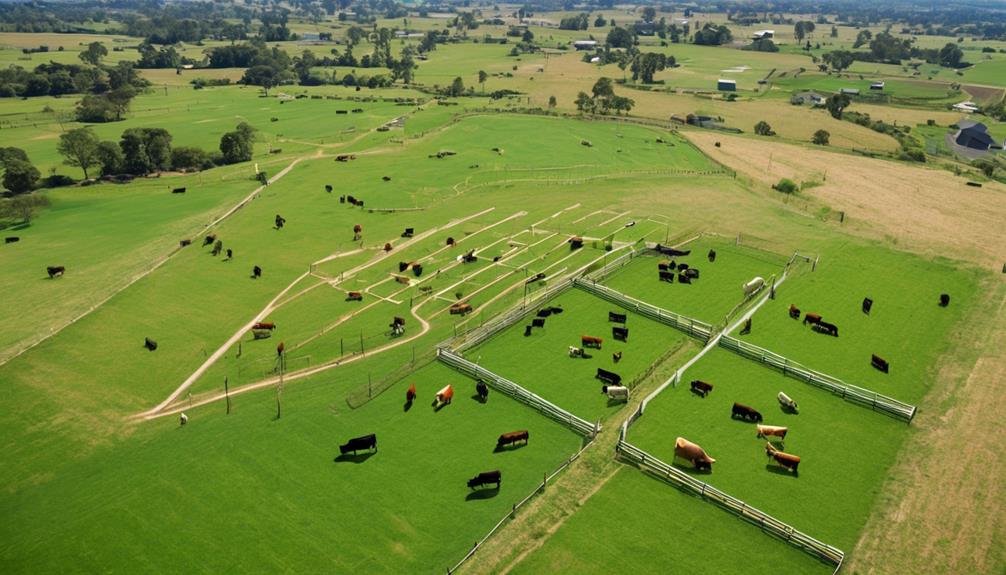
Consider setting up smaller paddocks within your pastures to implement an effective rotational grazing system for your cattle. This approach to grazing management can significantly improve pasture quality, reduce soil compaction, and contribute to grassland restoration.
By dividing your pastures into smaller sections and rotating your cattle through them, you can give the vegetation in each paddock ample time to recover and regrow, leading to improved pasture health and sustainability.
Rotational grazing helps in improving pasture quality by allowing the vegetation in each paddock to rest and rejuvenate. This method prevents overgrazing and gives the grass a chance to recover, leading to healthier and more nutrient-dense forage for your cattle. Additionally, rotational grazing reduces soil compaction as the cattle aren't continuously concentrated in one area, which promotes better water infiltration and nutrient cycling in the soil.
Furthermore, implementing a rotational grazing system contributes to grassland restoration by mimicking the natural grazing patterns of wild herbivores. This approach encourages diverse plant growth and helps to maintain a balanced ecosystem. By moving your cattle through smaller paddocks, you can also encourage the growth of different plant species, which can enhance the overall biodiversity of your pasture.
Utilizing Cattle Manure for Soil Fertility
You can enhance soil fertility on your cattle farm by effectively utilizing cattle manure. Proper manure management and nutrient recycling are essential for maintaining soil health and sustainability. Here's how you can make the most of cattle manure to enrich your soil:
- Manure Management: Start by collecting cattle manure regularly and storing it in a designated area. This helps prevent nutrient runoff and allows for better control over the application process. By managing the quantity and distribution of manure, you can avoid overloading the soil with nutrients and minimize the risk of environmental pollution.
- Composting Techniques: Consider implementing composting techniques to further enrich the manure. Composting not only helps to break down the manure into a more stable form but also reduces the risk of potential pathogens. Once properly composted, the manure can be used as an organic fertilizer, providing a balanced mix of nutrients that benefit soil health and plant growth.
- Soil Enrichment: Apply the composted cattle manure to your fields to enrich the soil. This natural fertilizer enhances soil structure, improves water retention, and promotes microbial activity. As a result, the soil becomes more fertile, leading to healthier pastures and increased productivity on your cattle farm.
Integrating Cover Crops in Cattle Farming
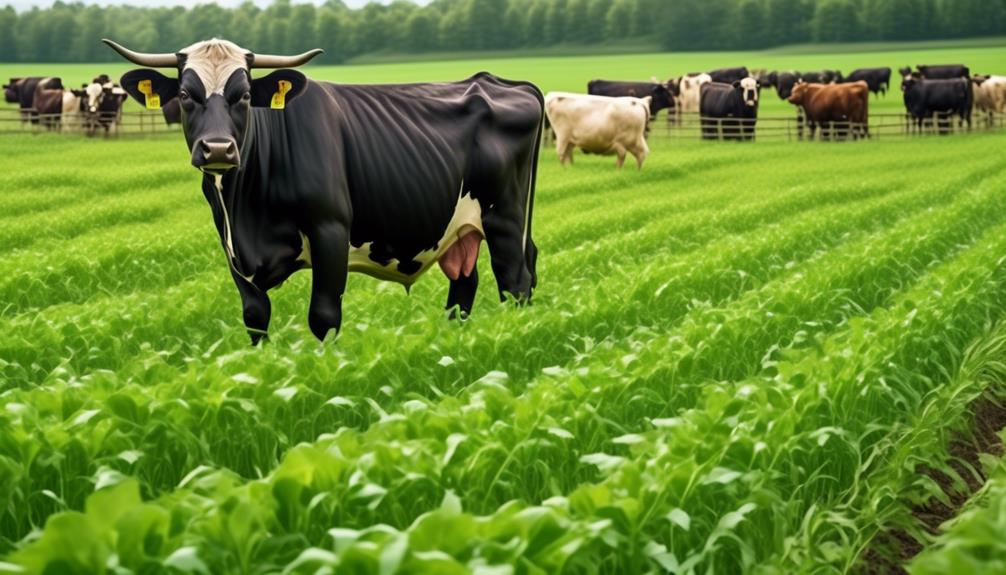
Integrating cover crops in cattle farming enhances soil fertility and sustainability, providing additional benefits to your farm's ecosystem.
Cover crops offer numerous advantages for soil health. They help in reducing erosion, improving soil structure, and increasing organic matter content. These benefits lead to enhanced water retention and nutrient availability, ultimately contributing to the overall health of your soil.
Additionally, cover crops play a vital role in grazing management. They provide a source of forage for cattle, allowing forage to be available during periods when perennial pastures are dormant. This not only supplements the nutritional needs of the cattle but also helps in managing grazing pressure on primary forage areas, preventing overgrazing and soil compaction.
Soil Erosion Prevention Methods for Cattle Farms
To protect your cattle farm from soil erosion, implement effective land management practices such as contour plowing and terracing. These methods help in reducing the speed of water runoff, thus preventing soil erosion. Additionally, incorporating erosion control measures like planting cover crops and maintaining grass buffers along waterways can significantly reduce soil erosion on your farm. By implementing these strategies, you can ensure the sustainability of your land for the long term.
Soil Erosion Prevention Methods for Cattle Farms
To prevent soil erosion on your cattle farm, consider the following effective methods:
- Contour Plowing: Plowing across the slope, as opposed to up and down, helps to reduce the speed of water runoff and minimizes soil erosion.
- Terracing: Constructing terraces on hilly terrain helps to slow down water flow, allowing it to soak into the soil and reducing erosion.
- Grazing Management: Implement rotational grazing to prevent overgrazing, which can lead to soil compaction and erosion. Proper grazing management ensures that grass cover is maintained, reducing the risk of erosion.
Benefits of Agroforestry in Cattle Farming
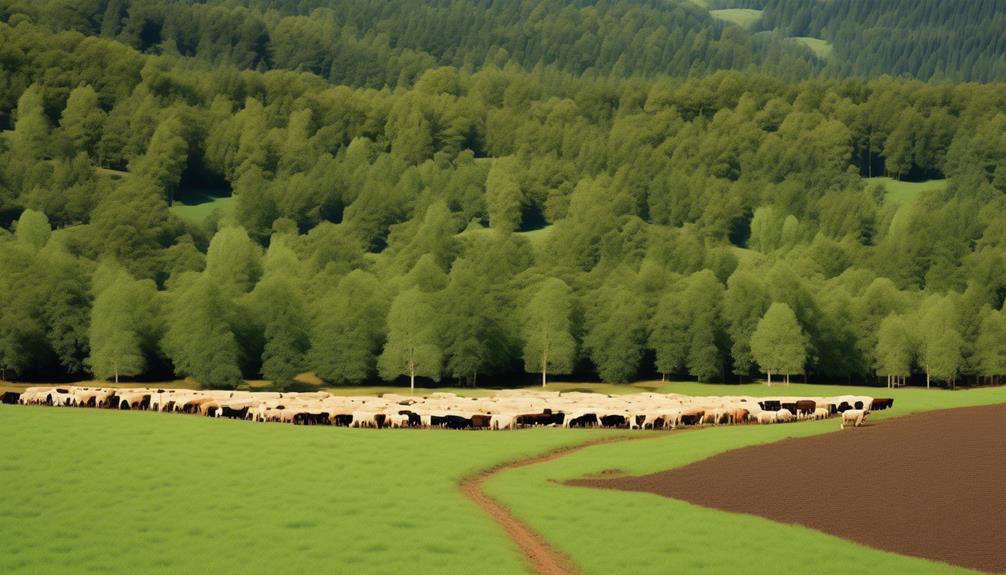
Agroforestry offers numerous benefits for cattle farming. By integrating trees and shrubs into pasturelands, agroforestry creates a more sustainable and productive environment for both livestock and the land. One of the key agroforestry benefits is the implementation of silvopasture techniques, which involves combining trees, forage, and livestock in a single system.
Silvopasture not only provides shade and shelter for cattle, reducing heat stress and improving animal welfare, but also contributes to improved soil health. The trees in silvopasture systems help prevent soil erosion by stabilizing the land and reducing runoff, thus preserving valuable topsoil and maintaining fertility.
Furthermore, agroforestry enhances biodiversity by creating diverse habitats for wildlife and beneficial insects. This, in turn, contributes to natural pest control and pollination, reducing the reliance on chemical inputs. The presence of trees also promotes carbon sequestration, mitigating the environmental impact of cattle farming by capturing and storing atmospheric carbon dioxide.
Additionally, integrating agroforestry practices on cattle farms can lead to diversified income streams through the production of timber, fruits, nuts, and other non-timber forest products.
Monitoring Soil Health Indicators for Cattle Operations
With the focus on sustainable cattle farming, understanding and monitoring soil health indicators is crucial for ensuring the continued benefits observed from agroforestry practices in your operations. By monitoring soil health indicators, you can make informed decisions about nutrient management and ensure the long-term sustainability of your cattle farming.
Here are three key soil health indicators to monitor for your cattle operations:
- Soil Testing: Regular soil testing is essential for assessing the nutrient levels in your soil. It provides valuable insights into the pH levels, nutrient deficiencies, and organic matter content, allowing you to make informed decisions about the application of fertilizers and soil amendments. Through soil testing, you can optimize nutrient management practices, preventing over-application of fertilizers and minimizing the risk of nutrient runoff into water bodies.
- Nutrient Management: Monitoring soil health indicators enables you to develop a targeted nutrient management plan. By understanding the nutrient levels and soil composition, you can tailor your fertilizer applications to meet the specific needs of your pastures. This not only promotes efficient nutrient utilization by the forage crops but also minimizes environmental impact by reducing excess nutrient leaching.
- Biological Activity: Assessing soil biological activity, including the presence of beneficial microorganisms and earthworms, is crucial for evaluating overall soil health. Healthy soil biology contributes to improved nutrient cycling, soil structure, and water retention, all of which are vital for sustaining healthy pastures and forage production.
Frequently Asked Questions
Can Cattle Farming Negatively Impact Groundwater Quality and How Can This Be Mitigated?
Cattle farming can negatively impact groundwater quality through manure runoff. Sustainable solutions include proper waste management, rotational grazing, and buffer zones to mitigate pollution. It's crucial for environmental stewardship and long-term soil health.
What Are the Potential Risks of Overgrazing on Soil Health and How Can These Be Prevented?
To prevent erosion and maintain soil health, managing grazing is crucial. Overgrazing can deplete vegetation, leading to erosion. Rotate pastures, monitor forage levels, and use rest periods to allow for regrowth. These actions promote sustainable grazing management.
How Can Cattle Farmers Effectively Manage Soil Compaction in Grazing Areas?
To manage soil compaction in grazing areas, focus on soil aeration and pasture rotation. By regularly aerating the soil and rotating pastures, you can enhance soil health and prevent compaction issues, ensuring sustainable cattle farming practices.
Are There Specific Challenges in Implementing Cover Crops in Regions With Extreme Weather Conditions, and How Can These Be Addressed?
In regions with extreme weather, implementing cover crops can be challenging. However, you can address this by selecting cover crop varieties that are resilient to harsh conditions and by adjusting planting and management practices accordingly.
What Are the Best Practices for Minimizing Soil Erosion in Hilly or Sloped Cattle Farming Areas?
To minimize soil erosion in hilly or sloped areas, implement terracing techniques to stabilize the soil. Consider land reclamation and effective water management practices. These strategies are vital for maintaining soil health and sustainability in such environments.
Conclusion
Soil health is crucial for sustainable cattle farming. By implementing rotational grazing, utilizing cattle manure for soil fertility, integrating cover crops, and preventing soil erosion, you can maintain a healthy and productive environment for your cattle.
Don't forget to monitor soil health indicators to ensure the success of your cattle farming operation. With these practices in place, you can improve the soil health of your farm and promote the sustainability of your cattle farming business.
